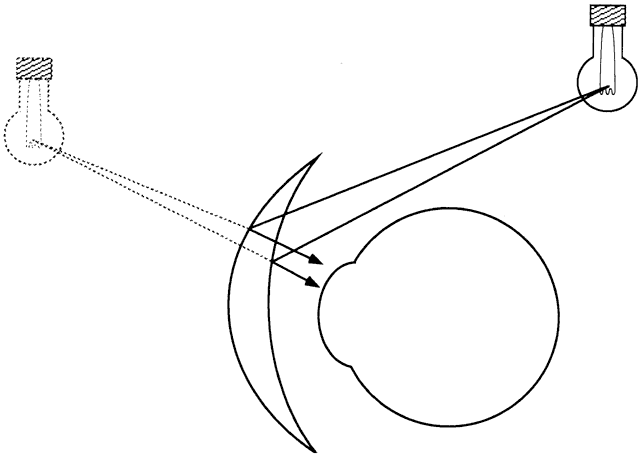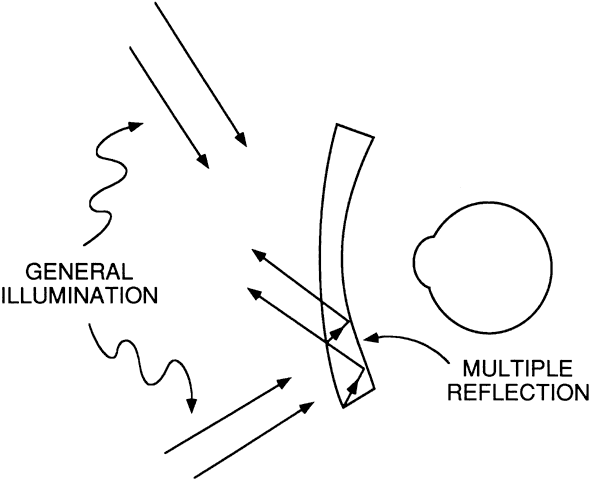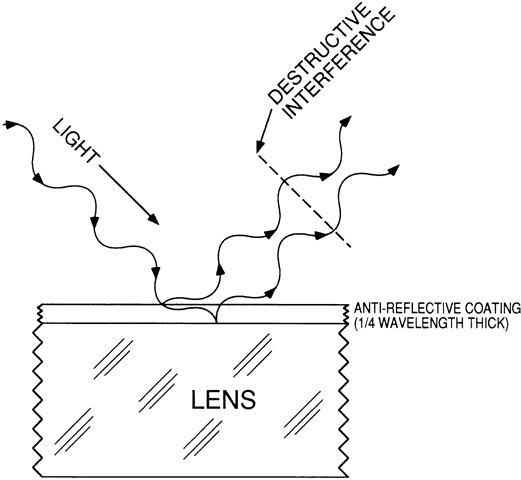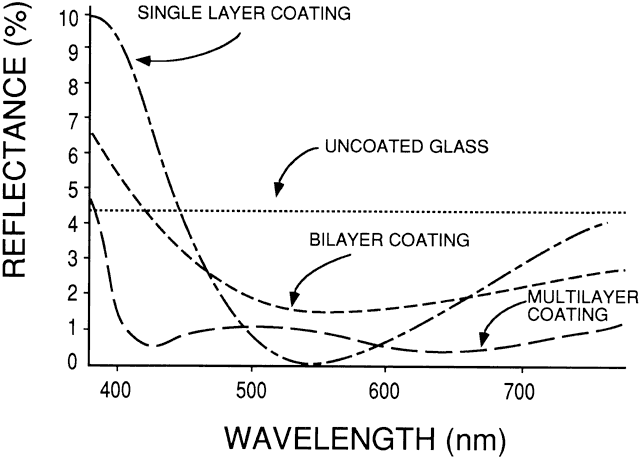1. American National Standard for Ophthalmics—Nonprescription Sunglasses
and Fashion Eyewear—Requirements, ANSI Z80.3-1996. Merrifield, VA: Optical
Laboratories Association, 1997 2. Hill AR, Stevenson RWW: Long-term adaptation to ophthalmic tinted lenses. Mod Probl Ophthalmol 17:264, 1976 3. Davis JK: Prescribing for visibility. Probl Optom 2:131, 1990 4. Hecht S, Hendley CD, Ross S, Richmond PN: The effect of exposure to sunlight on night vision. Am J Ophthalmol 31:1573, 1948 5. Peckham RH, Harley RD: The effect of sunglasses in protecting retinal sensitivity. Am J Ophthalmol 34:1499, 1951 6. Clark B, Johnson ML, Dreher RE: The effect of sunlight on dark adaptation. Am J Ophthalmol 29:828, 1946 7. Adams AJ, Haegerstrom-Portnoy G: Color deficiency. In Amos J (ed): Diagnosis
and Management in Vision Care, pp 671–713. Boston: Butterworths, 1987 8. Pokorny J, Smith VC, Verriest G, Pinckers AJLG: Congenital and Acquired
Color Vision Defects, pp 83–135. New York: Grune & Stratton, 1979 9. Pease P: Color vision. In Benjamin WJ (ed): Borish's Clinical Refraction, pp 242–302. Philadelphia: WB Saunders, 1998 10. Mecherikunnel AT, Richmond JC: Spectral distribution of solar radiation, NASA
Technical Memorandum 82021. Greenbelt, MD: NASA Goddard Space Flight
Center, 1980 11. Pitts DG: Ultraviolet radiation: When and why. Probl Optom 2:95, 1990 12. Council on Scientific Affairs: Harmful effects of ultraviolet radiation. JAMA 262:380, 1989 13. Pitts DG: The ocular ultraviolet action spectrum and protection criteria. Health Phys 25:559, 1973 14. Sliney D, Wolbarsht M: Safety with Lasers and Other Optical Sources, pp 187–215. New
York: Plenum Press, 1980 15. Davis JK: The sunglass standard and its rationale. Optom Vis Sci 67:414, 1990 16. American National Standard Practice for Occupational and Educational Eye
and Face Protection: ANSI Z87.1-1989. New York: American National Standards
Institute, 1989 17. Freedman A: Climatic droplet keratopathy: I. Clinical aspects. Arch Ophthalmol 89:193, 1973 18. Gray RH, Johnson GJ, Freedman A: Climatic droplet keratopathy. Surv Ophthalmol 36:241, 1992 19. Fraunfelder FT, Hanna C: Spheroidal degeneration of cornea and conjunctiva: 3. Incidences, classification, and
etiology. Am J Ophthalmol 76:41, 1973 20. Norn MS: Spheroidal degeneration, pinguecula, and pterygium among Arabs in the Red
Sea Territory, Jordan. Acta Ophthalmol (Copenh) 60:949, 1982 21. Detels R, Dhir SP: Pterygium: A geographical study. Arch Ophthalmol 78:485, 1967 22. Taylor HR, West SK, Rosenthal FS et al: Corneal changes associated with chronic UV irradiation. Arch Ophthalmol 107:1481, 1989 23. Taylor HR, West S, Munoz B et al: The long-term effects of visible light on the eye. Arch Ophthalmol 110:99, 1992. 24. Pitts DG, Cullen AP, Hacker PD: Ocular effects of ultraviolet radiation from 295 to 365 nm. Invest Ophthalmol Vis Sci 16:932, 1977 25. Hiller R, Sperduto RD, Ederer F: Epidemiologic associations with nuclear, cortical, and posterior subcapsular
cataracts. Am J Epidemiol 124:916, 1986 26. Taylor HR, West SK, Rosenthal FS et al: Effect of ultraviolet radiation on cataract formation. N Engl J Med 319:1429, 1988 27. Collman GW, Shore DL, Shy CM et al: Sunlight and other risk factors for cataracts: An epidemiologic study. Am J Public Health 78:1459, 1988 28. Bochow TW, West SK, Azar A et al: Ultraviolet light exposure and risk of posterior subcapsular cataracts. Arch Ophthalmol 107:369, 1989 29. West SK, Duncan DD, Munoz B et al: Sunlight exposure and risk of lens opacities in a population-based study: The
Salisbury eye evaluation project. JAMA 280:714, 1998 30. Pitts DG: The electromagnetic spectrum. In Pitts DG, Kleinstein RN (eds): Environmental
Vision: Interactions of the Eye, Vision, and the Environment, pp 87–135. Boston: Butterworth-Heinemann, 1993 31. Ham WT, Mueller HA, Ruffolo JJ et al: Action spectrum for retinal injury from near-ultraviolet radiation in the
aphakic monkey. Am J Ophthalmol 93:299, 1982 32. Schmidt RE, Zuclich JA: Retinal lesions due to ultraviolet laser exposure. Invest Ophthalmol Vis Sci 19:1166, 1980 33. Kamel ID, Parker JA: Protection from ultraviolet exposure in aphakic erythropsia. Can J Ophthalmol 8:563, 1973 34. Jordan DR, Valberg JD: Dyschromatopsia following cataract surgery. Can J Ophthalmol 21:140, 1986 35. Werner JS, Steele VG, Pfoff DS: Loss of human photoreceptor sensitivity associated with chronic exposure
to ultraviolet radiation. Ophthalmology 96:1552, 1989 36. Kraff MC, Sanders DR, Jampol LM, Lieberman HL: Effect of an ultraviolet-filtering intraocular lens on cystoid macular
edema. Ophthalmology 92:366, 1985 37. Wald G: The photochemistry of vision. Doc Ophthalmol 3:94, 1949 38. Wald G: Alleged effects of the near ultraviolet on human vision. J Opt Soc Am 42:171, 1952 39. Barker FM: Does the ANSI Z80.3 nonprescription sunglass and fashion eyewear standard
go far enough? Optom Vis Sci 67:431, 1990 40. Young RW: The family of sunlight-related eye diseases. Optom Vis Sci 71:125, 1994 41. Lerman S: UV radiation photodamage to the ocular lens: Diagnosis and treatment. Ann Ophthalmol 14:411, 1982 42. Pitts DG: Principles in ocular protection. In Pitts DG, Kleinstein RN (eds): Environmental
Vision: Interactions of the Eye, Vision, and the Environment, pp 259–280. Boston: Butterworth-Heinemann, 1993 43. Lydahl E, Philipson B: Infrared radiation and cataract: I. Epidemiologic investigation of iron- and
steel-workers. Acta Ophthalmol (Copenh) 62:961, 1984 44. Lydahl E, Philipson B: Infrared radiation and cataract: II. Epidemiologic investigation of glass
workers. Acta Ophthalmol (Copenh) 62:976, 1984 45. Lydahl E, Glansholm A: Infrared radiation and cataract: III. Differences between the two eyes
of glass workers. Acta Ophthalmol (Copenh) 63:39, 1985 46. Lanum J: The damaging effects of light on the retina: Empirical findings, theoretical
and practical implications. Surv Ophthalmol 22:221, 1978 47. Newsome DA, Berson E, Bonner R et al: Possible role of optical radiation
in retinal degenerations. In Waxler M, Hitchins VM (eds): Optical Radiation
and Visual Health, pp 89–101. Boca Raton, FL: CRC Press, 1987 48. Young RW: Solar radiation and age-related macular degeneration. Surv Ophthalmol 32:252, 1988 49. Hovis JK, Lovasik JV, Cullen AP, Kothe AC: Physical characteristics and perceptual effects of “blue-blocking” lenses. Optom Vis Sci 66:682, 1989 50. Borgwardt B, Fishman GA, Meulen DV: Spectral transmission characteristics of tinted lenses. Arch Ophthalmol 99:293, 1981 51. Anderson WJ, Gebel RKH: Ultraviolet windows in commercial sunglasses. Appl Opt 16:515, 1977 52. Stephens GL, Pitts DG: Evaluation of the performance of spectacle lens “transmittance meters.”Optom Vis Sci 71:220, 1994 53. Coroneo MT: Albedo concentration in the anterior eye: A phenomenon that locates some
solar diseases. Ophthalm Surg 21:60, 1990 54. Narayanan P, Merriam JC, Vazquez ME, Dillon J: Experimental model of light focusing of the peripheral cornea. Inv Ophthalmol Vis Sci 37:37, 1996 55. Schein OD, West S, Munoz B et al: Cortical lenticular opacification: Distribution and location in a longitudinal
study. Invest Ophthalmol Vis Sci 35:363, 1994 56. Rosenthal FS, Bakalian AE, Taylor HR: The effect of prescription eyewear on ocular exposure to ultraviolet radiation. Am J Public Health 76:1216, 1986 57. Rosenthal FS, Phoon C, Bakalian AE, Taylor HR: The ocular dose of ultraviolet radiation to outdoor workers. Invest Ophthalmol Vis Sci 29:649, 1988 58. Pitts DG: Sunglasses for ocular protection. In Pitts DG, Kleinstein RN (eds): Environmental
Vision: Interactions of the Eye, Vision, and the
Environment, pp 299–313. Boston: Butterworth-Heinemann, 1993 59. Young JM: AR coating: A definition. Optical World 17:8, 1988 | 
















